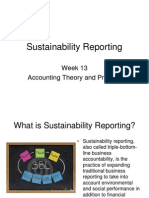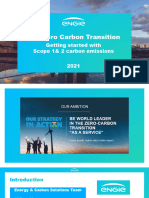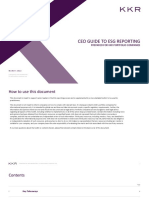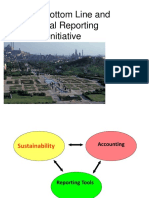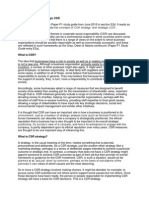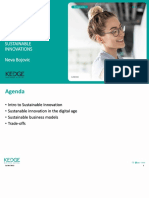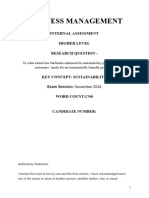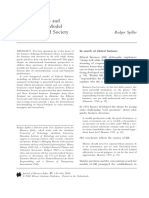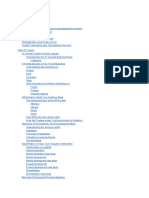Introduction To Sustainability Reporting
Introduction To Sustainability Reporting
Uploaded by
Ramon JudillaCopyright:
Available Formats
Introduction To Sustainability Reporting
Introduction To Sustainability Reporting
Uploaded by
Ramon JudillaOriginal Title
Copyright
Available Formats
Share this document
Did you find this document useful?
Is this content inappropriate?
Copyright:
Available Formats
Introduction To Sustainability Reporting
Introduction To Sustainability Reporting
Uploaded by
Ramon JudillaCopyright:
Available Formats
White Paper: An Introduction to Sustainability Reporting
An Introduction to Sustainability Reporting
There is a growing movement, worldwide, to not only be a more responsible corporate citizen, but to trade on that fact and Sustainability Reporting is the lynchpin of this undertaking for many organizations. Sustainability Reporting is the practice for commercial, public sector, and non-profit organizations alike of raising awareness and making positive change to how the organization impacts the environment and people. Sustainability Reporting is a relatively new discipline, without the global standards and accepted controls of financial accounting; however, this is fast changing. Sustainable Business, Corporate Social Responsibility, Environmental and Social Risk Assessments are other terms heard increasingly in business, investment and governance forums today and this belies the growing significance of this activity. Some of these terms are used interchangeably. We use the term Sustainability Reporting to include reporting at its broadest level, which addresses financial, social and environmental topics.
What Is Sustainability Reporting
A Sustainability Report presents information about a companys (or organizations) progress toward implementing sustainable business practices. The report will typically report on progress toward key business objectives: Decrease its environmental footprint (including water and energy use) Improve its financial bottom line and operate the organization ethically Improve its relationships with stakeholders, including relationships with its employees and the communities in which it operates.
Companies have traditionally demonstrated their financial responsibility through quarterly and annual reports, relegating societal accountabilities to public relations efforts and marketing brochures. Sustainability Reporting adds social and environmental performance to these accomplishments. This marks a major milestone in corporate accountability. There are many forms that a Sustainability report can currently take, each valid in its own objectives and context. Reporting initiatives can include Environment, Health and Safety Reports, Corporate Social Charters. A key aspect to reporting is putting in place measures - including baseline measures - and objectives for improvement on these measures. In this way, areas of concern or interest to the audience of a report can be monitored and the organization can demonstrate progressive improvements. Audiences for these reports will include customers, pressure groups, potential investors, shareholders, fund managers, governmental regulatory organizations and students. Each of these groups will have particular areas of focus and need the information presented in different ways. Communication of information via the Sustainability Report must be done with sensitivity and care with any and all audiences.
2007 SustainabilityWorks
Page 1 of 8
www.SustainabilityWorks.biz
White Paper: An Introduction to Sustainability Reporting
Triple Bottom Line
The principles of Triple Bottom Line ensure that organizations account equally for Economic, Social and Environmental factors as inputs, outputs and internal processes of their business. The principles of the Balanced Scorecard provide a strong parallel; however, Triple Bottom Line takes the scorecard into a realm that extends beyond direct impacts of the organization. This now allows an organization to address indirect impacts, long-term and very long-term risk and to take advantage of incentives to be proactive on social and environmental issues. Ultimately, there is no value in excellence in Environmental Stewardship and Social Initiatives if the organization is unable to sustain itself financially to survive.
CERES and Global Reporting Initiative (GRI)
A sustainability report is often written according to guidelines issued by the Global Reporting Initiative and/or consistent with CERES reporting guidelines. The Coalition for Environmentally Responsible Economics (CERES) was founded in 1988 and is now the worldwide leader in standardized corporate environmental reporting and the promotion of transformed environmental management within companies. Formed out of a partnership between some of America's most progressive investors and environmental groups, CERES has pioneered an innovative, practical approach toward encouraging greater corporate responsibility on environmental issues. Convened by CERES in partnership with the United Nations Environment Programme (UNEP), the Global Reporting Initiative (GRI) was established in 1997. GRI is now a multi-stakeholder process and independent institution whose mission is to develop and disseminate globally- applicable Sustainability Reporting Guidelines. These Guidelines are for voluntary use by organizations for reporting on the economic, environmental and social dimensions of their activities, products and services. GRI became independent in 2002, and is an official collaborating centre of the United Nations Environment Programme (UNEP) and works in cooperation with UN Secretary-General Kofi Annans Global Compact. GRI is considered, world-wide, to be the best set of guidelines developed to date.
Structure of a Sustainability Report
Begin by thinking of the Annual Report to Shareholders from a publicly-owned company. A published Sustainability Report works on the same principles, but on a wider context, giving equal weighting to environmental and social factors as it would to economic. The structure of the report is similar. The following description of the report reflects GRI guidelines:
2007 SustainabilityWorks
Page 2 of 8
www.SustainabilityWorks.biz
White Paper: An Introduction to Sustainability Reporting Company Profile/Statement of Intent: This is really the equivalent of the President or CEO's Statement declaring the "state of the nation" and what commitments the organization is planning on making with the reasoning behind it. Vision and Strategy: This area will provide a context to the three types of measures, providing an overview of the value adding activates of the company.
Each of the following sections will discuss initiatives that address specific concerns and how they are being monitored, progress achieved and the trade-offs being made. Economic Measures: These include the financial inputs and outputs and subsidies, breakdowns by business area, geography, how well managed the collections are, how well the organization manages to negotiate purchasing, and profitability. Environmental Measures: This section includes material inputs and outputs, energy and waste management, impact of substances used and processes employed, logistics, compliance with regulations and reduction, re-use and re-cycling policies. Social Measures: This section includes employee management to ensure fair treatment, compensation and employment policy, health and safety initiatives, investment in staff, human rights policy exerted on partners, contributions in money and kind to communities where the organization operates, sociopolitical influences and compliance with regulations.
Each of these sets of measures demonstrates the health of the organization and its exposure to particular types of risk. Metrics with year-on-year comparisons: Like a financial report, this section includes actual and normalized values (expressed in comparable measures or ratios) with year-on-year comparisons, where possible. Generally presented in tabular form with footnotes that link to exceptions.
(charts taken from CERES 2001 Sustainability Report to show normalized measures) Exceptions: This section will provide reasons where items are not normalized or even reported on. It also includes explanations of specific measures where a simple numeric indicator does not tell the whole story. For example, a business that rented commercial office and retail property was tracking energy emissions of its facilities. When it disposed of its retail and warehouse properties there was a large reduction in total square footage and because office properties have high emissions (due to air conditioning requirements), the overall energy emissions per square foot increased considerably. This
2007 SustainabilityWorks
Page 3 of 8
www.SustainabilityWorks.biz
White Paper: An Introduction to Sustainability Reporting change was necessary for the economic sustainability of the business and therefore requires certain clarifications. There are alternative reporting formats and delivery methods depending on the business and communication objectives. These include: Operational and Financial Review (OFR) - established as a mandatory reporting format in the UK from January 2005 for all companies traded on the Financial Times Stock Exchange. As yet, no strict guidelines for reporting exist, other than the requirement to report with more specific requirements in the pipeline as companies enable themselves with this initiative. Environmental, Health & Safety Reports are a long standing requirement for many companies and in many cases they have significant overlap with many aspects of sustainability reporting. Websites and reports published for Socially Responsible Investment (SRI) funds that track specific measures that the fund managers focus on. An organization that is being tracked by multiple SRI funds will use such a report to consolidate handling the individual enquiries from different fund analysts resulting in a very tangible saving in administration costs and being able to be proactive in addressing fund manager's questions.
Benefits of Sustainability Reporting
The benefits are threefold, each one with a matrix of positive effects.
Good Business Practice
When a business or organization chooses to report, whichever objectives it has, it will undergo an exercise where it captures and makes public its findings. This focuses attention upon business practices that are suboptimal or just plain bad business. For manufacturers, waste management is one such area that highlights bad practice to improve upon poor waste management metrics will usually involve making processes more efficient in terms of waste produced per volume of actual goods.
Compliance
Where regulatory bodies have created strict regulations or even loose guidelines, organizations need to comply or face whatever penalty is imposed. Such penalties may be blacklisting or a recommendation not to purchase or invest or for government imposed regulatory compliance, then a possible jail sentence.
Positive Public Relations
People like to do good and they prefer to support companies that also do good. Therefore, when two companies are competing and the only difference between them is the perception of how socially and environmentally responsible they are, then this may be the competitive edge. Therefore, the use of the sustainability report and similar stakeholder communications can be a positive way to communicate to key audiences.
Anticipated Results of Sustainability Reporting for the Reporting Organization
Improved management tools to measure and benchmark performance, internally and externally. Increased ability to compare and reduce costs especially if the report is integrated into a companys reporting processes. Page 4 of 8 www.SustainabilityWorks.biz
2007 SustainabilityWorks
White Paper: An Introduction to Sustainability Reporting Improved ability to ensure that suppliers business processes are consistent with your companys brand and value system. Reduced costs because the results of reporting should identify and eliminate waste and often helps identify new business opportunities. Improved communications because a common reporting format provides a set of indicators that can be used to discuss performance among stakeholders.
Anticipated Results of Sustainability Reporting for report users:
Increased ability of banks, investors and ratings organizations to benchmark and rate companies. Using a standard reporting protocol helps provide high quality and comparable information about corporate performance. Increased ability of stakeholders, including government and advocacy groups, to assess the quality of a company managements governance ability, especially its ability to anticipate and respond to emerging issues. Increased ability of employees, customers, and other stakeholders to obtain information about corporate social and environmental responsibility policies and activities.
Preparing the Report
If you are considering whether to produce a Sustainability Report, the reasons for doing so are compelling (and on this website, we tend to promote these reasons due to the nature of our work). But, indeed, there are a number of issues you need to consider before leaping into this activity: 1. Sustainability Reporting is not a one-off activity Once you have begun, people will be interested in the information you have gathered, what you are concluding and they will be interested in the ongoing improvements made. This will apply as much to an internal audience as an external one. To attempt to produce a fully accredited / comprehensive sustainability report in one go is an ambitious undertaking. Although it has been achieved, you must realize the capabilities of your organization and that significant changes in direction will require political maneuvering, change management and simple organizational inertia. The first iteration may be only for internal publication.
2. Start small
2007 SustainabilityWorks
Page 5 of 8
www.SustainabilityWorks.biz
White Paper: An Introduction to Sustainability Reporting 3. Make sure you get executive commitment Because of the significant impact of a report in todays business environment, gaining executive commitment is essential and to see the project through, executive support is also highly desirable. (Note: the CEO must sign the report if following CERES or GRI guidelines.) If you are producing a report in a compliance situation, ensure that you have a full understanding of the regulations and exceptions. There may not be a need to report or the need may be greater than you realize. Also the regulations may become tighter as time progresses and your reporting goals may need to move with them. A deep understanding of whom you are reporting to is vital because this will determine the nature of your reporting project. Advocacy or NGO groups will require a very different emphasis in a report than one to SRI fund managers. Your project will always be at risk from internal obstacles, despite even the most fervent executive support. Almost certainly you will find that individual objectives and performance metrics run contrary to sustainability principles and shining a light on such practices will stand to put somebody in an awkward position. Be sensitive to these situations and handle them pragmatically. Remember, perfection is the enemy of progress.
4. Understand the nature of compliance
5. Understand your audience
6. Anticipate internal obstacles
When you are certain that this is what you want to do, you can embark on the journey, one that we hope that will be rewarding and fruitful for all of your stakeholders.
Steps to Preparing a Sustainability Report
1. Educate Yourselves Ensure that your core team has a thorough understanding of what is required and why, including knowledge of regulatory bodies and audience groups Carry out a preliminary study to determine the value of this exercise and the amount of effort required. Understand the time periods, the impact on the organization to produce the report and most importantly anticipate the impact on your organization when the report is published.
2. Feasibility Study
2007 SustainabilityWorks
Page 6 of 8
www.SustainabilityWorks.biz
White Paper: An Introduction to Sustainability Reporting 3. Executive Sponsorship Create a compelling argument for producing a report, back it up with a realistic ROI and anticipate where push-back will occur. Gain the support of multiple executives and time commitment from their staff in departments whose help you will be seeking. Determine the precise set of reasons why you are producing the report and set a number of objectives that will satisfy those reasons. Additionally produce an ongoing communications strategy (preferably two-way) to allow you to manage how you deliver the report content to your audience groups. Determine the needs of your reporting project in terms of resources, budgets, timeframes and external factors. Examine gaps in what you have and what is required and ensure that these gaps can be plugged. In this phase you should also provide a detailed analysis of potential objections and risks and for each a mitigation plan. Overall provide a contingency plan. Detailed task allocation, establish milestones, plan resource utilization, build in appropriate contingency. This activity will be an ongoing one throughout the duration of the project. Determine metrics you will be reporting on and levels of detail, locate sources of data and triangulate to ensure accuracy when dealing with multiple sources, work out how to normalize the data across your organization, provide mechanisms for capturing data from remote locations, provide storage facilities for holding and organization data and finally tools to access the data and to format it into reports. The process of creating the report, writing the executives statement, ensuring appropriate narrative and accurate data. If following a standardized set of guidelines, such as GRI, or adhering to a set of guidelines, ensure that these are well defined at the start of the process. Ensure that the formats being produced are done with prior knowledge of the dissemination strategy. Execute your communication strategy, probably best done in phases for maximum impact. Ensure that mechanisms for two-way communication (e.g. 1-800 numbers, email addresses) are active and work effectively.
4. Establish Objectives
5. Needs Assessment
6. Project Planning
7. Data Capture
8. Report Creation
9. Report Dissemination
2007 SustainabilityWorks
Page 7 of 8
www.SustainabilityWorks.biz
White Paper: An Introduction to Sustainability Reporting 10. Capture Feedback Capture feedback from all audience groups and all participants in the reporting process. Ensure that these are well documented and used to improve the next reporting cycle.
Potential Pitfalls
1. Effect on metrics of changing context Metrics like the processes that they measure are not static. As context changes, whether it be the process itself or what your organization is trying to achieve, there will be an effect on the metrics that you report. Each time you collect a metric, step back and look at it in context and anticipate the reaction of your audience Your open and honest communication can be used against you. Advocacy or NGO groups will often require more of you; there may be criticism that your performance is poor. If you anticipate this, then you will be able to have more in-depth responses to explain your actions and what you are doing to improve. Once you begin on the road to reporting or even implementing more proactive communication to your audiences, it takes on a life of its own. Customers and the media will likely be interested in what you are reporting and what more you will be doing in the future.
2. Positive and negative communications
3. The snow-ball effect
Reporting Suggestions
Provide clear, consistent, and relevant information that addresses the needs and concerns of your stakeholders. Provide absolute values of the market, goals, and value created for the companies' (or organizations) stakeholdersexpressing sustainable activities in terms of their financial value and goals for the next year, for example. Provide a management tool to help continuously evaluate and improve sustainable performance. Promote a true picture of the company. The more candid the report, the more positive its effect on the company's reputation. Stakeholders will feel confident that the company will strive to achieve its goals over the long term. Include or exist cohesively with other reporting standards, such as financial reports. Facilitate comparisons with competitors.
2007 SustainabilityWorks
Page 8 of 8
www.SustainabilityWorks.biz
You might also like
- Green Business Plan Guide PDFDocument25 pagesGreen Business Plan Guide PDFSasya PutiNo ratings yet
- Introducing The Gri Standards PresentationDocument23 pagesIntroducing The Gri Standards PresentationSebastian Gonzalez100% (2)
- Why Is Strategic Management Considered Important For Global Market CompetitionDocument2 pagesWhy Is Strategic Management Considered Important For Global Market CompetitionEmz Jolets50% (2)
- ESG Ratings Methodology Exec SummaryDocument17 pagesESG Ratings Methodology Exec SummaryPrachi BahugunaNo ratings yet
- Toolkit On ESG For Fund ManagersDocument25 pagesToolkit On ESG For Fund ManagersMariah Sharp100% (1)
- Five Ways That ESG Creates Value PDFDocument12 pagesFive Ways That ESG Creates Value PDFAtifKhan100% (1)
- Netflix ESG Report 2020Document23 pagesNetflix ESG Report 2020utpalnath100% (1)
- Chapter 17 TestbankDocument42 pagesChapter 17 TestbankJustonlyou100% (1)
- A Framework To Measure Corporate Sustainability Performance A Strong Sustainability-Based View of Firm PDFDocument18 pagesA Framework To Measure Corporate Sustainability Performance A Strong Sustainability-Based View of Firm PDFSonia Ramirez100% (1)
- Dess9e Chapter01 TB AnswerkeyDocument49 pagesDess9e Chapter01 TB AnswerkeyRannie MedinaNo ratings yet
- Business and Sustainable Development-1Document12 pagesBusiness and Sustainable Development-1ammukuttyidukkiNo ratings yet
- Lecture 10 - Sustainability ReportingDocument23 pagesLecture 10 - Sustainability ReportingKing Kong100% (1)
- Sustainability AccountingDocument10 pagesSustainability AccountingAaron ShannonNo ratings yet
- C12 Sustainability ReportingDocument54 pagesC12 Sustainability Reportingazhar rizkiNo ratings yet
- Sustainability Reporting Guidelines: Mapping & Gap Analyses For Shanghai Stock ExchangeDocument60 pagesSustainability Reporting Guidelines: Mapping & Gap Analyses For Shanghai Stock ExchangeIFC SustainabilityNo ratings yet
- Global Reporting InitiativeDocument57 pagesGlobal Reporting Initiativesurbhimo100% (1)
- Sustainability AccountingDocument14 pagesSustainability AccountingRahul Pramani100% (2)
- Sustainability ReportingDocument12 pagesSustainability ReportingNor Ihsan Abd LatifNo ratings yet
- Esg Reporting Guide enDocument28 pagesEsg Reporting Guide enSalah Eddine100% (2)
- Key Takeaways: October 23, 2018 October 23, 2018Document20 pagesKey Takeaways: October 23, 2018 October 23, 2018Basanth0% (1)
- ESG Indicators in Annual Reports An Introduction To Current Frameworks 1105 Colour2652011551650Document30 pagesESG Indicators in Annual Reports An Introduction To Current Frameworks 1105 Colour2652011551650freemind3682100% (4)
- Environmental, Social and Governance (ESG) Activities - Research SpotlightDocument18 pagesEnvironmental, Social and Governance (ESG) Activities - Research SpotlightStanford GSB Corporate Governance Research Initiative80% (10)
- ESG What You Need To KnowDocument20 pagesESG What You Need To KnowRudy HendrartoNo ratings yet
- Appendix A IFRS S1 Sample WorksheetDocument4 pagesAppendix A IFRS S1 Sample WorksheetcontactpulkitagarwalNo ratings yet
- 02 PrinciplesDocument16 pages02 PrincipleszillsmkNo ratings yet
- Nareit Brand Guidelines:: Nareit Guide To ESG Reporting FrameworksDocument18 pagesNareit Brand Guidelines:: Nareit Guide To ESG Reporting Frameworkssiddharth singhNo ratings yet
- SSRN Id3557432Document29 pagesSSRN Id3557432Zerohedge100% (1)
- Carbon Accounting ValuationDocument4 pagesCarbon Accounting ValuationVaibhav SharmaNo ratings yet
- Materiality and Sustainability Disclosure - SGX Top50 - Ernst & Young Thought Leadership Oct2015Document20 pagesMateriality and Sustainability Disclosure - SGX Top50 - Ernst & Young Thought Leadership Oct2015Krishna SadashivNo ratings yet
- Ey Esg SuiteDocument6 pagesEy Esg Suitepeter ivanovNo ratings yet
- Webinar Getting Started With Scope 1 2 Carbon Emissions SlidesDocument69 pagesWebinar Getting Started With Scope 1 2 Carbon Emissions Slidestankeanleong100% (1)
- Lecture 10 Eco LabelingDocument12 pagesLecture 10 Eco LabelingSaif UllahNo ratings yet
- Sustainability Reporting ICAIDocument56 pagesSustainability Reporting ICAIaminjagNo ratings yet
- A Starters Guide To Sustainability ReportingDocument76 pagesA Starters Guide To Sustainability ReportingEnrique Navarrete Morales100% (1)
- Accounting ClimateDocument29 pagesAccounting ClimatesailendrNo ratings yet
- GIIN Impact Investing GuideDocument20 pagesGIIN Impact Investing GuidefizalfizalNo ratings yet
- Getting More Value Out of Sustainability ReportingDocument32 pagesGetting More Value Out of Sustainability ReportingIFC Sustainability100% (1)
- ESG & Impact Investing 101 - Invest Your Savings SustainablyDocument34 pagesESG & Impact Investing 101 - Invest Your Savings SustainablyWarren AckermanNo ratings yet
- 1 Sustainability ReportingDocument28 pages1 Sustainability Reportingmaulikravat3No ratings yet
- Proceedings of The Blue Economy Assessment Inception WorkshopDocument29 pagesProceedings of The Blue Economy Assessment Inception WorkshopPEMSEA (Partnerships in Environmental Management for the Seas of East Asia)No ratings yet
- Environmental and Social Management System (ESMS) Implementation Handbook - METAL PRODUCTS MANUFACTURINGDocument64 pagesEnvironmental and Social Management System (ESMS) Implementation Handbook - METAL PRODUCTS MANUFACTURINGIFC Sustainability100% (1)
- Environmental Guideline For Smart Cities July 2015Document3 pagesEnvironmental Guideline For Smart Cities July 2015rvsingh17gmailcomNo ratings yet
- MBS Corporate Finance 2023 Slide Set 3Document104 pagesMBS Corporate Finance 2023 Slide Set 3PGNo ratings yet
- IFRS Issb 2023 B Ifrs s1 General Requirements For Disclosure of Sustainability Related Financial Information Accompanying Guidance Part BDocument17 pagesIFRS Issb 2023 B Ifrs s1 General Requirements For Disclosure of Sustainability Related Financial Information Accompanying Guidance Part BLucy PaongananNo ratings yet
- CEO Guide To ESG ReportingDocument19 pagesCEO Guide To ESG ReportingDaniel nemeses Espina100% (1)
- KPIs For ESG 3 0 FinalDocument174 pagesKPIs For ESG 3 0 FinalLucho Paolantonio100% (1)
- Consolidated Set of The GRI Standards 2021Document774 pagesConsolidated Set of The GRI Standards 2021R.Anita.W100% (1)
- Esg Scores MethodologyDocument12 pagesEsg Scores MethodologyIGift Wattanatorn80% (5)
- Case Study Sustainable Finance Royal PhilipsDocument31 pagesCase Study Sustainable Finance Royal PhilipsZak Elmkd100% (1)
- Endroof ESG Sustainability PolicyDocument8 pagesEndroof ESG Sustainability Policyjoseph koigiNo ratings yet
- Sample Content BRSR, ESG & Sustainability MasterclassDocument32 pagesSample Content BRSR, ESG & Sustainability MasterclassburhanuddinsaifyNo ratings yet
- Corporate Sustainability: Jane Okun Bomba Chief Sustainability, IR and Comms Officer IHS Inc. February 2014Document24 pagesCorporate Sustainability: Jane Okun Bomba Chief Sustainability, IR and Comms Officer IHS Inc. February 2014ReveJoyNo ratings yet
- Investment Philanthropy, by Contrast, Is Philanthropy As The Result of Charitable Investments. Within ThisDocument8 pagesInvestment Philanthropy, by Contrast, Is Philanthropy As The Result of Charitable Investments. Within ThisAnkur ShuklaNo ratings yet
- Tools and Techniques of Environmental Accounting For Business DecisionsDocument32 pagesTools and Techniques of Environmental Accounting For Business DecisionsRonoNo ratings yet
- Corporate Sustainability Survey and ESG Trends KoreaDocument30 pagesCorporate Sustainability Survey and ESG Trends Koreaandy.gNo ratings yet
- GRI Reporting in Government AgenciesDocument16 pagesGRI Reporting in Government AgenciesHabib Muhammad ShahibNo ratings yet
- TCFD Implementation GuideDocument65 pagesTCFD Implementation GuideRania Syahira100% (1)
- 7 Sustainability ReportingDocument14 pages7 Sustainability Reportingmaulikravat3100% (1)
- Triple Bottom Line & GRIDocument39 pagesTriple Bottom Line & GRILuis Nash100% (1)
- GRI IndexDocument8 pagesGRI IndexTarun Majumdar100% (1)
- Assurance Engagement - ISAE 3000Document19 pagesAssurance Engagement - ISAE 3000Daniel DadaNo ratings yet
- CSR Strategy and Strategic CSRDocument11 pagesCSR Strategy and Strategic CSRHsn Igcse100% (1)
- Preparing For Mandatory Sustainability DisclosuresDocument34 pagesPreparing For Mandatory Sustainability DisclosuresimportaculoNo ratings yet
- Introduction To Sustainability ReportingDocument8 pagesIntroduction To Sustainability Reportingadilla ikhsaniiNo ratings yet
- Business AdministrationDocument64 pagesBusiness AdministrationAnonymous XybLZfNo ratings yet
- Session 1 Intro To Sustainable InnovationDocument42 pagesSession 1 Intro To Sustainable InnovationSaul HortaNo ratings yet
- Achieving Shared Triple Bottom Line Value CreationDocument25 pagesAchieving Shared Triple Bottom Line Value CreationMpumi de BeesNo ratings yet
- Assist. Mirela-Oana Pintea PH.D Student: Provided by Research Papers in EconomicsDocument12 pagesAssist. Mirela-Oana Pintea PH.D Student: Provided by Research Papers in EconomicsRabia SabirNo ratings yet
- Mar3023 Exam 1 Review-1Document31 pagesMar3023 Exam 1 Review-1Anish SubramanianNo ratings yet
- Final Business IADocument14 pagesFinal Business IAcr7g2712No ratings yet
- Carte Sustainable-Business-Cases CAP 6Document58 pagesCarte Sustainable-Business-Cases CAP 6Mihaela AlbuNo ratings yet
- Green Banking For Green EnvironmentDocument13 pagesGreen Banking For Green EnvironmentRitesh KumarNo ratings yet
- Africa CEOs Survey 2020 vEN PDFDocument68 pagesAfrica CEOs Survey 2020 vEN PDFOffice NewacoNo ratings yet
- Green and Black'S CSR Policy Strategic ManagementDocument20 pagesGreen and Black'S CSR Policy Strategic ManagementKrisna RubyNo ratings yet
- Strategy and The Changing EnvironmentDocument10 pagesStrategy and The Changing EnvironmentJoawanna TuduNo ratings yet
- Bba - 2513 - Bba-Ac-14-31Document11 pagesBba - 2513 - Bba-Ac-14-31Safwan RafaideenNo ratings yet
- Ethical Business and Investment - A Model For Business and SocietyDocument12 pagesEthical Business and Investment - A Model For Business and SocietyMuchammad Zaenal MuttaqinNo ratings yet
- Strategy Productivity Tools - Table of ContentDocument17 pagesStrategy Productivity Tools - Table of ContentViral VideosNo ratings yet
- Paper 17 21082019 PDFDocument408 pagesPaper 17 21082019 PDFNeha Kesarwani100% (1)
- Validating and Expanding A Framework of A Triple Bottom Line Dominant Logic For Business Sustainability Through Time and Across ContextsDocument24 pagesValidating and Expanding A Framework of A Triple Bottom Line Dominant Logic For Business Sustainability Through Time and Across ContextsmutiNo ratings yet
- Sustainable TextilesDocument90 pagesSustainable TextilesMoisa Vica100% (4)
- 19e Section6 LN Chapter09Document10 pages19e Section6 LN Chapter09benbenchenNo ratings yet
- CIA3003 SustainabilityDocument49 pagesCIA3003 SustainabilityWong Yong Sheng WongNo ratings yet
- OM OperationsDocument6 pagesOM OperationsRoosy RoosyNo ratings yet
- Astra SR 2010Document106 pagesAstra SR 2010Fred's SiagianNo ratings yet
- Assist. Mirela-Oana Pintea PH.D StudentDocument12 pagesAssist. Mirela-Oana Pintea PH.D Studentyahon92No ratings yet
- Marketing - 8th Edition - Chapter 3 - SlidesDocument53 pagesMarketing - 8th Edition - Chapter 3 - Slideschelsea frederickNo ratings yet
- Multi-Criteria Decision Analysis Framework For Sustainable Manufacturing in Automotive IndustryDocument17 pagesMulti-Criteria Decision Analysis Framework For Sustainable Manufacturing in Automotive IndustryFMNo ratings yet
- 6 ECCI - Karthik SubbaramanDocument13 pages6 ECCI - Karthik SubbaramanThe Outer MarkerNo ratings yet


















